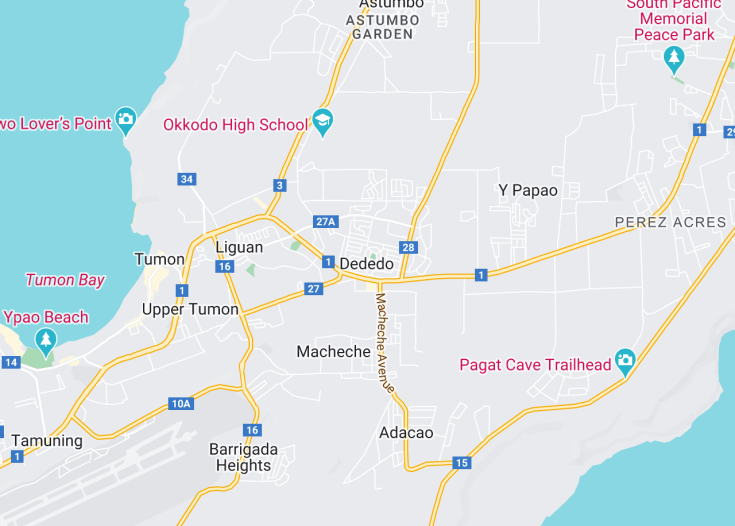Dededo, the most populous village in Guam, offers a fascinating mix of cultural heritage and modern attractions, making it a prime destination for those exploring the Pacific islands. The area is characterized by its vibrant community, bustling markets, and rich history, including significant World War II sites. Visitors can enjoy local cuisine at the lively flea markets, relax at beautiful beaches, or delve into the local Chamorro culture through various festivals and events. Dededo’s diverse offerings cater to both adventure seekers and those looking to unwind in a tropical setting.
Explore the weekly Dededo flea market for a unique shopping experience where you can find local crafts, fresh produce, and savory treats.
Plan your visit during one of Dededo’s cultural festivals to fully immerse yourself in the rich Chamorro traditions and vibrant local community.
How to best experience Dededo?
Search for Tickets, tours, and activities in Dededo using direct search on the following providers:
GetYourGuide.com Viator.com Trip.com Expedia.com Tiqets.com Ctrip.com (中文)
Dededo: Gateway to Tropical Paradise
| Country | Guam (USA) |
| Time in Dededo | GMT+10 |
| Language spoken | English, Chamorro |
| Population | 44,943 (2020 Census) |
| Currency | United States Dollar (USD $) |
| Airports | Antonio B. Won Pat International Airport (3 mi / 4.8 km). |
Dededo, the most populous village on the island of Guam, USA, offers a unique blend of indigenous Chamorro tradition and modern American influences, making it a fascinating destination for tourists. It serves as a hub of economic activity in the region, with numerous shopping complexes, business districts, and a vibrant community life. The stunning tropical beaches nearby, combined with the local hospitality, provide a delightful experience. Historically, Dededo has had significant growth since World War II as it transformed from a small rural community into a bustling suburban area. Today, it is known for its cultural sites, including the Latte Stone Park and the Micronesia Mall, Guam’s largest shopping center. Celebrations such as the annual Liberation Day parade and other community events are deeply entrenched in its cultural calendar, showcasing Dededo’s spirited lifestyle and rich heritage.
Where is Dededo?
Dededo is situated in the northern region of Guam, just north of the capital, Hagåtña.
Distances:
| Route | Distance by car | Time by car |
|---|---|---|
| Hagåtña to Dededo | 8.4 miles | 16 mins |
| Tamuning to Dededo | 6.6 miles | 14 mins |
What is Dededo famous for?
Dededo is renowned for its role as a commercial heart in Guam and for hosting major festivals including the vibrant Liberation Day celebrations that draw visitors and locals alike, fostering a strong sense of community and cultural pride within this bustling locale.
History
The history of Dededo, the most populous village in Guam, is rich and complex, tracing back thousands of years to its original settlers, the Chamorro people.
Pre-Colonial Era (Before 1521)
The Chamorro people, skilled navigators and craftsmen, had been populating Guam for nearly 4,000 years before Spanish explorers arrived on the island. Dededo, with its fertile lands and resources, served as a vital hub for these indigenous inhabitants, facilitating flourishing communities that engaged in fishing, hunting, and agriculture.
Spanish Colonization (1521-1898)
The arrival of Ferdinand Magellan in 1521 marked the beginning of a new era in Guam’s history. Dededo, like much of Guam, came under Spanish control and faced significant cultural and demographic shifts. The Spanish influence is evident from the introduction of Christianity and new agricultural practices to the imposition of new governing structures. During this period, Dededo grew in strategic importance, although this also led to challenging times during conflicts such as the Spanish-Chamorro Wars.
American Acquisition and World Wars (1898-Present)
Following the Spanish-American War in 1898, Guam was ceded to the United States. Dededo’s strategic location became even more accentuated during World War II, where it experienced significant hardship under Japanese occupation from 1941 to 1944. Post-war, Dededo transformed significantly due to American military presence and infrastructural developments. The construction of Andersen Air Force Base brought profound economic and social changes to the village, facilitating modern amenities and a multicultural population influx, shaping Dededo into a diverse and bustling community it is today.
Visit Dededo
What to see and do in Dededo, Guam (USA)
Dededo offers a blend of natural beauty and cultural heritage. Visitors can explore the beautiful beaches such as Ritidian Point, known for its pristine sands and clear waters. The Latte Stone Park is another must-visit, showcasing limestone pillars used by ancient Chamorros. For shopping enthusiasts, the Micronesia Mall provides a vast selection of goods and entertainment options. Outdoor activities are plentiful, including hiking and bird watching in the nearby wildlife refuges.[/ul][li]
Festivals and Events in Dededo
Dededo is vibrant with culture and celebrations. The Mango Festival, occurring annually in May, is a highlight, attracting locals and tourists alike with its display of local crafts, foods, and mango-themed competitions. Additionally, the Liberation Day Parade every July commemorates Guam’s liberation from Japanese occupation with vibrant floats and festive performances.
Best time to visit Dededo
The best time to visit Dededo is between January and May, when the weather is most favorable. This period avoids the heavy rains and potential typhoons of the latter months, providing optimal conditions for exploring the outdoor attractions and participating in local events.
Is Dededo worth visiting?
Dededo offers a unique insight into Guam’s rich history and cultural diversity, making it a worthwhile visit for those interested in exploring the Chamorro heritage and natural beauty. However, visitors should be prepared for the humid tropical climate, which might be challenging for some. The presence of military bases adds to the local economy but may influence the cultural atmosphere. Overall, Dededo’s blend of history, culture, and nature provides a compelling destination for travelers seeking depth and diversity in their travels.

